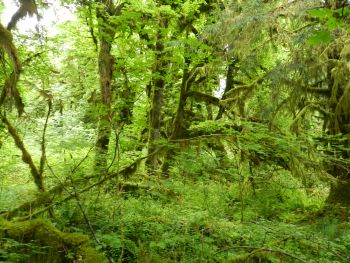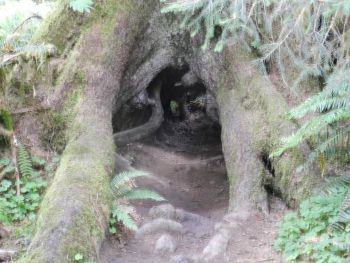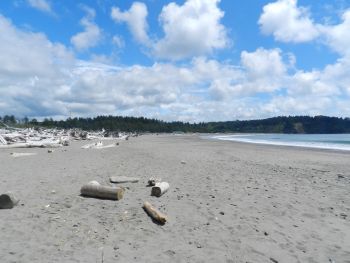Unsatisfying surf
Three of the world's few temperate rainforests
are found on the Olympic Peninsula in Washington, which was the main reason I
wanted to visit the place, and we chose to visit Hoh Rainforest, located along
the Hoh River. To get to the rain forest, we had to drive around 12 miles south
from Forks on US 101 and then 18 miles east to the visitor center. Hoh
rainforest is part of the Olympic National Park, so when we entered the park we
took the opportunity to spend
 $
80 on an annual pass for all U.S. National Parks, National
Monuments etc. Before making that big decision, we had had a ong discussions about
the profitability of the matter. In 2010 we visited a lot of national parks, and
back then it was a really good idea. This time, we expected to visit
a lot fewer, so we were not sure whether it was profitable. Eventually,
however, we agreed to make the investment in the hope that it would pay off. In the
end it happened to be a reasonably good deal. We would probably have spent over $
100 paying for admission to all the places where we now could use the
pass.
$
80 on an annual pass for all U.S. National Parks, National
Monuments etc. Before making that big decision, we had had a ong discussions about
the profitability of the matter. In 2010 we visited a lot of national parks, and
back then it was a really good idea. This time, we expected to visit
a lot fewer, so we were not sure whether it was profitable. Eventually,
however, we agreed to make the investment in the hope that it would pay off. In the
end it happened to be a reasonably good deal. We would probably have spent over $
100 paying for admission to all the places where we now could use the
pass.
From the
park entrance, we continued to the Visitor Center. Here it turned out that there
were two relatively short trails, you could walk, and then a longer hike. The
hike was 17 miles each way to the top of a mountain and demanded an overnight
stay along the way, so we gav e up on that. We decided though to
take both of the short trails.
We
started with the trail, called the Hall of Mosses, and I have to admit that moss was
abundant on the trees. The rainforest is not like a tropical jungle. The trees are
mostly spruce, pine, western hemlock and other conifers, but there are
also were som deciduous trees, and they were all more or less covered with moss.
The walk was very exciting and although it didn't rain while we were there, we could easily
feel the moisture - and everything seemed to be green. Even the pictures we took
look overly green for the most part.
The moss itself was greyish yellow, so in some places where the moss had completely
overgrown the trees, the green color disappeared and was replaced by a withered
grey. On
our walk along the trail we met a few other people, including some who obviously
were members of a photo club and they dragged several suitcases of equipment along with them. They
seemed to be so busy taking pictures that they did not have time to enjoy the rainforest. We also saw
one raccoon on a tree trunk, but it did not kept still long enough to be
photographed by my more modest equipment. Later we saw an animal that showed
itself very briefly. To briefly for a sure identification, but it lookled like
a bobcat.
 When we got back to the main trail, we immediately
continued to the next trail,
called Spruce Nature Trail. It was a lot longer than the first one we had taken,
so in total we walked about 4 miles in the rainforest. Luckily it was not that hot that day, but
the humidirty was rather high.
When we got back to the main trail, we immediately
continued to the next trail,
called Spruce Nature Trail. It was a lot longer than the first one we had taken,
so in total we walked about 4 miles in the rainforest. Luckily it was not that hot that day, but
the humidirty was rather high.
Along this
path, there was moss-covered trees as well, but not quite as many as along Hall
of Mosses. On
the other hand, there were many large, even very large spruce trees. I got a picture of Tim,
standing next to a Sitka spruce, which also grows
in Denmark. In Denmark they typically reach heights between 100 and 130 feet, while this
tiny tree was more than 260 feet tall and about 9 feet in diameter. Not
exactly a Christmas tree for the living room. Some of the world's tallest sitka
spruces and
douglas firs grow in this area. Douglas firs can grow even taller than the
sitkas. In fact, they can grow up to almost 400 feet, which is exceeded only by
coast redwoods.
The ones in the Hoh Rain Forest are not that tall though; we had to "make do" with heights between
250 and 300 feet. The almost 180 inches of annual precipitation provides good nourishment
for the trees.
On this last trail, we passed a lot of trees growing from nurse logs, and some
where the nurse logs had completely decayed, leaving tunnels through the
trees near or between the roots. Near thr end of the trail we walked along the Hoh River, which at this time of
year floated quietly, but in other seasons is a torrent that flood large areas
of rainforest, and thus helps to nurture this. When we had completed the trail,
we decided to leave the forest and return to the beach again. The day before I had
made my feet wet the Pacific, but since Tim wore shoes and socks, he didn't had experience,
which we would now remedy. We would however not go to Rialto Beach.
 We
would be going in the same direction though, so we drove back towards Forks and through the
town and west towards the Pacific Ocean on Washington Road 110. This time we drove to the very small town of La Push. This small settlement
is "the capital" of the Quileute Indian Reservation. 371 of the 2,000 something
members of the tribe live on the reservation, and the vast majority of these live in La Push but
also in other places, such as in the even smaller settlement, Mora. The
total area of the reservation is only about 1.5 square miles, but even so there are three separate beach areas within
the reservation boundaries, and to make it easy they are called First Beach, Second
Beach and Third Beach. First Beach is located in La Push itself, and is the easiest
to get to, so that was the one we had chosen to visit. It was on the way here
that we met a sign reading: "No vampires beyond this point." This is also a reminder of the Twilight series, in which
Quileuteindians can change
to the shape of wolves. They are enemies of the vampires in
Forks, and a treaty between the two parties forbid vampires on the reservation! The local Indians,
that we met, never
took advantage of this shapeshifting ability though, at least not while we were there.
I am certain that I could have taken a lot of interesting photos of humans
turning into wolves, and it would have been a great experience.
We
would be going in the same direction though, so we drove back towards Forks and through the
town and west towards the Pacific Ocean on Washington Road 110. This time we drove to the very small town of La Push. This small settlement
is "the capital" of the Quileute Indian Reservation. 371 of the 2,000 something
members of the tribe live on the reservation, and the vast majority of these live in La Push but
also in other places, such as in the even smaller settlement, Mora. The
total area of the reservation is only about 1.5 square miles, but even so there are three separate beach areas within
the reservation boundaries, and to make it easy they are called First Beach, Second
Beach and Third Beach. First Beach is located in La Push itself, and is the easiest
to get to, so that was the one we had chosen to visit. It was on the way here
that we met a sign reading: "No vampires beyond this point." This is also a reminder of the Twilight series, in which
Quileuteindians can change
to the shape of wolves. They are enemies of the vampires in
Forks, and a treaty between the two parties forbid vampires on the reservation! The local Indians,
that we met, never
took advantage of this shapeshifting ability though, at least not while we were there.
I am certain that I could have taken a lot of interesting photos of humans
turning into wolves, and it would have been a great experience.
Unfortunately the beach did not satisfy Tim, even though it had an impressive number of dead trees that had washed up as driftwood, both on the beach and along the Quileute River. The beach is set in a bay, and in consequence Tim didn't find that the surf was wild enough! We were therefore "forced" to leave and return to Rialto Beach, where the surf was more satisfying - and resulted in not just wet feet, but also wet shorts. When Tim was sufficiently wet, we returned to Forks, where we drove around so Tim could take pictures of things marked Twilight.
Here in the Twilight Zone, not far from several Indian reservations, we chose to have dinner on what later proved to be the only foreign restaurant on the whole trip, and what was more appropriate than - Chinese!
-
Return to Cross Country Tour -
- Return to
Travel stories -